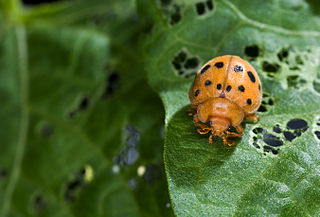
Asexual reproduction is a type of reproduction that does not involve the fusion of gametes or change in the number of chromosomes. The offspring that arise by asexual reproduction from either unicellular or multicellular organisms inherit the full set of genes of their single parent and thus the newly created individual is genetically and physically similar to the parent or an exact clone of the parent. Asexual reproduction is the primary form of reproduction for single-celled organisms such as archaea and bacteria. Many eukaryotic organisms including plants, animals, and fungi can also reproduce asexually. In vertebrates, the most common form of asexual reproduction is parthenogenesis, which is typically used as an alternative to sexual reproduction in times when reproductive opportunities are limited. Komodo dragons and some monitor lizards can reproduce asexually.

The telephone-pole beetle is a beetle native to the eastern United States, and the only living representative of the otherwise extinct family Micromalthidae. They have an unusual life cycle involving asexually reproducing (parthenogenetic) female larvae, as well as non-functional "ghost adults".

Thelytoky is a type of parthenogenesis and is the absence of mating and subsequent production of all female diploid offspring as for example in aphids. Thelytokous parthenogenesis is rare among animals and reported in about 1,500 species, about 1 in 1000 of described animal species, according to a 1984 study. It is more common in invertebrates, like arthropods, but it can occur in vertebrates, including salamanders, fish, and reptiles such as some whiptail lizards.
Coccinella novemnotata, the nine-spotted ladybug or nine-spotted lady beetle or C9, is a species of ladybug in the family Coccinellidae native to North America. This beetle was once ubiquitous across the continent but experienced a sharp and drastic decline around the 1960’s. Now, considered a rare species, the nine-spotted ladybug has received much attention from researchers who wish to understand the causes of its decline and restore the population of this charismatic beetle to benefit from their aphidophagous nature as biocontrol agents in agriculture.

Parthenogenesis is a natural form of asexual reproduction in which growth and development of embryos occur in a gamete without combining with another gamete. In animals, parthenogenesis means development of an embryo from an unfertilized egg cell. In plants, parthenogenesis is a component process of apomixis. In algae, parthenogenesis can mean the development of an embryo from either an individual sperm or an individual egg.

Coccinellidae is a widespread family of small beetles. They are commonly known as ladybugs in North America and ladybirds in the United Kingdom; "lady" refers to mother Mary. Entomologists use the names ladybird beetles or lady beetles to avoid confusion with true bugs. The more than 6,000 described species have a global distribution and are found in a variety of habitats. They are oval beetles with a domed back and flat underside. They are sexually dimorphic; adult females are larger than males. Many of the species have conspicuous aposematic (warning) colours and patterns, such as red with black spots, that warn potential predators that they taste bad.

The Epilachninae are a subfamily of the family of lady beetles, the Coccinellidae, in the order Coleoptera. Superficially, they look much like other ladybirds in the larger subfamily Coccinellinae, but they differ importantly in their biology, in that the members of the subfamily are largely or completely leaf-feeding herbivores rather than being predators. Accordingly, several members of the subfamily are crop pests, and sometimes cause locally serious crop losses.

The Coccidulinae are a subfamily of lady beetles in the family Coccinellidae. Recent molecular analyses suggest that Coccidulinae is not a monophyletic group.
Didion is a genus of dusky lady beetles in the family Coccinellidae. There are at least three described species in Didion.
Nephus sordidus, known generally as the little brown mealybug destroyer or sordid ladybug, is a species of dusky lady beetle in the family Coccinellidae. It is found in North America.
Scymnobius atramentarius is a species of dusky lady beetle in the family Coccinellidae. It is found in North America.
Scymnobius guttulatus is a species of dusky lady beetle in the family Coccinellidae. It is found in North America and Oceania.
Scymnobius intrusus is a species of dusky lady beetle in the family Coccinellidae. It is found in North America.
Scymnobius flavifrons, the yellow-fronted lady beetle, is a species of dusky lady beetle in the family Coccinellidae. It is found in North America.
Scymnobius timberlakei is a species of dusky lady beetle in the family Coccinellidae. It is found in North America.
Scymnobius quadrarius is a species of dusky lady beetle in the family Coccinellidae. It is found in North America.
Pseudaspidimerus is a genus of beetles belonging to the family Coccinellidae. The genus has primarily Oriental origin and consists with 11 described species.

Scymnus (Scymnus) nubilus, is a species of lady beetle found in Pakistan, India, Bangladesh, Sri Lanka, Nepal, Myanmar, China, and Asia Minor.
Brumoides lineatus, sometimes known as broad vein-longitudinal striped ladybug, is a species of lady beetle found in China, Myanmar, Thailand, Bangladesh, India, Sri Lanka, Nepal, and Pakistan.
Adira is a genus of beetles in the family Coccinellidae. It was first described by Gordon & Almeida, 1986









